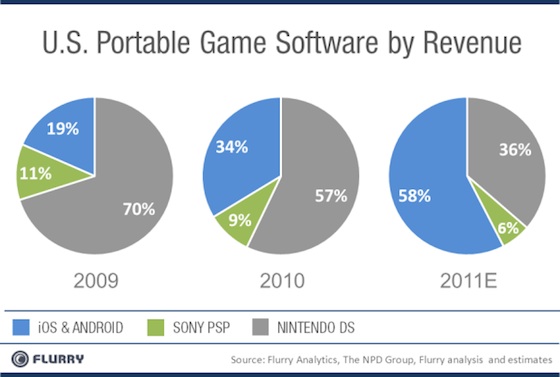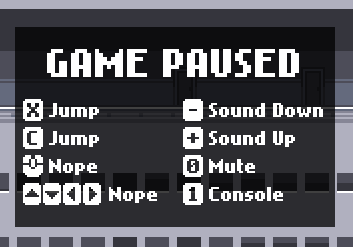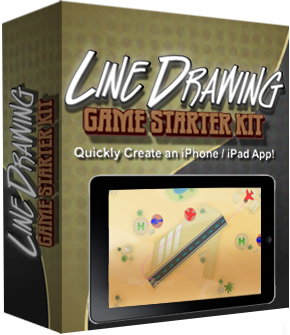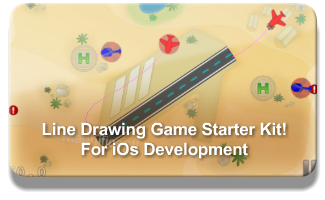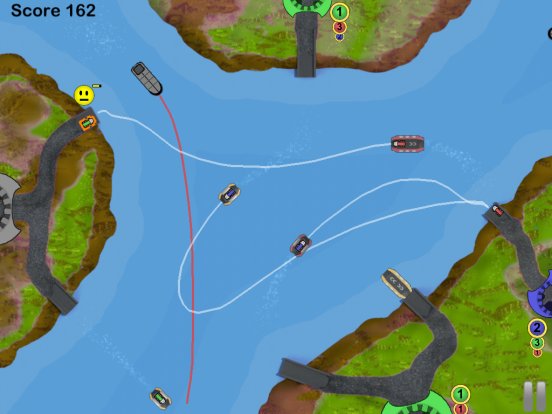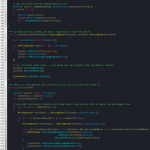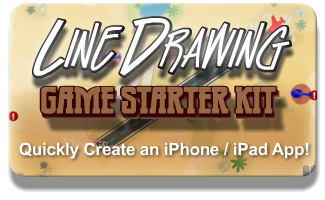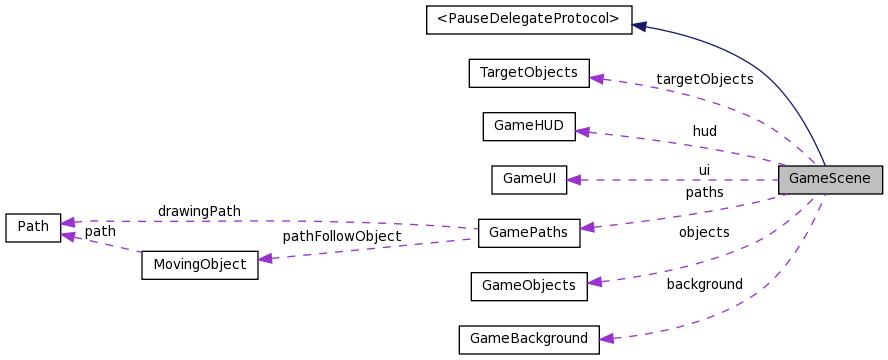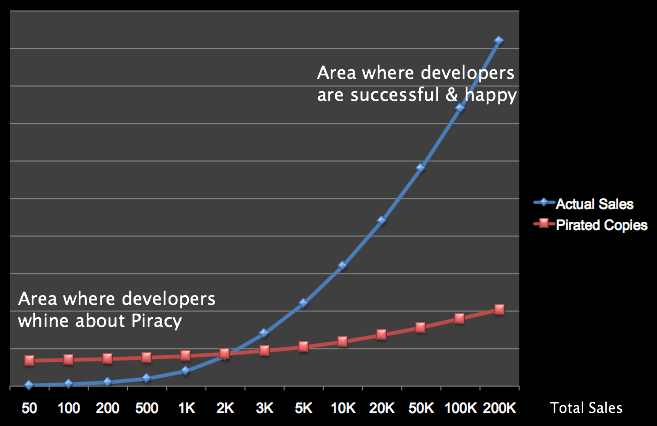This is a guest post by Nat Weiss, author of the cocos2d-iphone RPG Game Engine and the cocos2d-x Paralaxer Game Kit. Today he shares his experience working with the two most popular cocos2d game engines, and explains how and where they’re different.
He also needs more beta-testers for his latest game: Awesome Heroes Arena.
Over the last year, my bro Kristopher Horton and I have been developing a realtime Multiplayer-Online Battle Arena (MOBA) game for tablets with cocos2d-x. The game’s called Awesome Heroes Arena and we are finally at the point of taking on beta testers: here’s the beta sign up if you are interested.
Steffen thought it would be interesting if I shared some thoughts on switching from cocos2d-iphone to cocos2d-x. What’s it like? What things do I miss?
Why did we choose cocos2d-x?
The iOS & Android mobile game revenue has jumped from 19% to 58% in 3 years. While these numbers are only percentages and do not reflect an overall growth in the market, it does make one thing very clear: the dedicated handheld gaming devices are losing market share big time. And just as the 3DS has failed to inspire consumers so will in all likelihood the PS Vita. Continue reading »
With each new iOS device you’ll be sure to hear this argument:
“It doesn’t support Flash! Baaaaah, piece of crap!”
What bothers me most is that this mantra is repeated even by intelligent people, even developers fall into that behavior. But they don’t have an argument other than “I want it, I want it”. No really, it’s actually “I think I want it, I think I want it”. Why?
“Uh … well, Flash games!”
Here’s the problem …
If you like playing Flash games, either some in particular or generally consuming the daily new dose of throwaway games, you’ll be emotionally connected to these games. Of course you would want to play them on any device that seems perfectly capable of running Flash. So I understand the notion of wanting to have Flash on an iOS device. It’s entirely understandable.
What really bothers me, is how little even intelligent people put into what they’re actually demanding. Here’s a smack in the face - think about it!
Other examples include:
“Press any key to continue.”
“Use WASD to control your character, Space to jump, Ctrl to shoot.”
“Move the mouse cursor to the edge of the screen area to scroll in that direction.”
First of all …
All games that make use of the keyboard are out. Add to that the games which require a mousewheel or the distinction of left and right mouse clicks. I bet this will disqualify at least half of all Flash games. I expect that estimate is likely to be much higher if someone were to compile actual statistics of Keyboard and Mouse input use in Flash games.
Next, any game that relies on the concept of “mouse over” won’t work satisfactory, or not at all. There is no “mouse over” on a touchscreen device, there is only “drag & drop”. You have to touch the screen to move the cursor - it’s possible that games will interpret this as some kind of click and click, or drag and drop operation.
Finally, there’s the matter of precision. A mouse cursor has a hotspot that has an exact pixel position. A finger has a touch area, and although you can calculate the center point to be the touch location, it will be quite imprecise. Especially when you consider that users don’t see the exact point they’re touching - their finger is blocking the view. No Flash game has been designed to take into account that the clickable area will have a relatively large range of uncertainty. Many hidden objects games require you to touch locations to almost pixel-perfect accuracy - not to mention the unspeakable horrors of Flash UI Design with small fonts and even smaller buttons.
If you go into details, I’m sure there’ll be plenty more design issues. They may be subtle but overall important enough to make some games less enjoyable, unfair, unplayable or allow for exploits which could skew the highscores towards either mobile or web users. That’s bad.
Technical reasons
There are of course technical reasons why Flash, and specifically Flash games, won’t work well on an iPad or iPhone. The 1 GHz Dual-Core CPU of the iPad 2 is still an order of a magnitude slower than the slowest, Intel-based Mac Mini which clocks in at around 1.8 GHz (also Dual-Core). On older iDevices there’s only a single core ARM CPU with around 500 MHz. And surely you’ve experienced Flash games that didn’t run too well on a Mac mini, right? Imagine how they would perform on a mobile device.
Then we have the memory issue. The iOS devices have at most 512 MB of memory down to 128 MB. Not that bad, unless you consider how much is actually available for Apps. On a 128 MB device it’s just 30-35 MB. Not much you can do with that, and I don’t expect any Flash game to be optimized for this constrained amount of memory. Worse yet, a Flash game won’t receive memory warnings from the device and it’s developer certainly won’t respond to this warning. Plus, since running in the browser, the browser on the iDevice will consume some of the available memory itself. So what you get is some content-heavy Flash games and apps which will simply crash at a certain point, or not run at all because they’re out of memory. That’s not a good user experience.
We also have to consider the issue of screen resolution. Most Flash games run in a window with varying dimensions. On an iOS device, first of all you’d never get the fullscreen experience because the native resolution will almost always be different. Since Flash runs in the browser, the Flash games will have to be zoomed and scaled to fit the screen. In the worst case, the user has to do this manually because double-tapping inside the Flash window probably would be interpreted by Flash as a command, rather than by the browser as the command to zoom and fit the double-tapped content. In any case scaling the content will degrade visual quality while consuming more power because the content needs to be scaled (in most cases: up) by either the CPU or GPU.
What about Loading bars? Do you like loading bars? I’m sure you do. Because on an iDevice, the best you’ll get is a WiFi connection. I suppose that’ll be acceptable. But what if you’re on the road and only get 3G or even Edge? Do you like waiting several minutes for your Flash game to start up every time you run it? I don’t think so. Just try to remember how Flash websites felt back in the 90s when all we had were dial-up connections.
This could be better if …
Yes, if the iOS devices or even the iPads supported Flash, I’m sure Flash developers would take a little more care of the details that they actually can take care of. For example providing a real touch-aware user interface, or designing the whole game with touchscreen devices in mind.
However, only a minority of Flash developers would do so. The low costs of developing Flash apps and games doesn’t make cross-platform compatibility a real possibility for most. They make 90% or more of their revenue from hosting them on ad-supported gaming websites like Kongregate. Any other platform than the web has no relevance to Flash developers, and the iPad simply wouldn’t change that.
Once you do have a successful Flash game, it’s also much more lucrative to simply make an iOS version of it. Take for example Canabalt. It’s free on the web, but it sells for a relatively high price of $2,99 on iTunes. It’s also wildly successful. And it’s also a good example of why many Flash games simply won’t work on an iDevice - the screenshot further up is from the Flash version of Canabalt.
But Flash is good for other things!
Yes, if you like Ads, sure.
Oh, you mean those designer websites that you can’t even figure out how to use on your desktop? No?
What then … don’t tell me Youtube or those other movie sites. For one, there’s an App for that. And trust me, you’ll be too busy doing other stuff with your iPad than watching Youtube videos.
“There’s this site that won’t work …” - Really, you visit www.disney.com every day? You’re adorable! 
So far I have not come across a website that’s entirely Flash-driven (eg won’t work without Flash) and that has you coming back. The one that gets closest is github.com - but no point in downloading source code to your iDevice, is there? Most Flash-only websites are once-in-a-lifetime show-off events. A comedy act, if you so will. The second time, it’s just not as much fun. And you can absolutely live without them.
I run a Flashblocker on my browsers, all I’m missing are Ads and rarely a few gizmos that I don’t even notice aren’t there. Almost all websites are intelligent enough to default back to a non-Flash version, which not only works better, it’s also easier to use, loads faster and consumes less memory and CPU time. There you go.
To put it bluntly
Flash has no place on the iPad, or any iDevice.
My real problem with that is the people who repeat the “no Flash support” mantra don’t stop to think about the actual problems in supporting Flash apps and games on a device like the iPad. It just won’t deliver the same experience as it does on the desktop. Those experiences can not be brought over to a mobile device by merely supporting a specific technology.
Moreover, I wish those in favor of Flash support for iPad would actually make an argument, rather than repeating “But that’s what I want.” - you’re like little kids who can literally only be dragged past a candy shop or toy store, crying all along. No toys for you, grow up!
This list is a collection of exemplary games and apps made with the Cocos2D for iPhone game engine. They should be seen as reference products in terms of what you can do with Cocos2D and simply the variety of games and apps developers have created with Cocos2D. This post is linked to from the Cocos2D book.
If you wish to add a game or app to this list, and you can provide prove or guarantee that it was made with Cocos2D, please leave a comment. From time to time I’ll move the notable mentions up to the actual blog post and delete it from the comments (to avoid duplication) but you can still grab some attention and a little traffic to your game by simply adding a comment to it here. And don’t forget that the official Cocos2D website has a games page, where you can also add yours.
Note: the order of the apps in this list is arbitrary, although I try to group similar apps together.
The “Great Apps Made With Cocos2D” List
The Elements (iPad) is a graphical representation of the periodic table of elements. The outstanding feature is the plentiful photographs and smooth 360 animations which invite you to explore the elements that make up you, me and the rest of the universe (excluding empty space, of which there’s a lot I’ve been told). It’s priced highly but worth every cent, and if you need an App to brag about your new iPad: this is it!
Note: iPad demo starts at 2:55
Bloomies is a colorful gardening game, full of bees. If that doesn’t sway you over, maybe the idea of fostering and nurturing your own garden does. The flowers need your constant attention and the gameplay is addictive just like any Tamagotchi-style game. Oh, and it happens to be made by two former colleagues of mine. It’s just a beautiful game, and so is their follow-up game Super Blast.
StickWars is a sort of Tower Defense game where you defend your castle from incoming stick figures by flicking them in the air or literally shaking them to the ground. The developer, John Hartzog, had never before worked with Objective-C or on mobile devices but he pulled it off. StickWars remains to this date within the Top 100 games and continues to be updated even a years after the initial release.
ZombieSmash is also a Castle Defense game, except that this time hordes of zombies are attacking and you get explosives, 16 ton weights, shotguns and other cool items that make a bloody mess to fend them off. Your castle is your barn and if you can defend it, you’ll be rewarded with a slow motion animation of the final zombie losings its, err, unlife. The outstanding feature of this game is certainly the ragdoll animation system that allows zombies to walk, crawl or otherwise try to move even if they lost some of their limbs.
Super Turbo Action Pig revives a simple gameplay concept of a scrolling level where your character always falls down except when you touch the screen to boost his jetpack. The extraordinary part here is that the game’s graphics are extremely well made and the overall presentation of the game, the trailer, the website and the humor are setting a great example.
Farmville, do I even have to explain what it’s about? It’s an incredibly successful Facebook game that has millions of players worldwide building their farms in an isometric landscape. It just goes to show how powerful Cocos2D is if a company like Zynga uses it to port it’s most successful game to the iPhone.
Zombie Farm came out on the iPhone even before Farmville, and it was also created with Cocos2D. It does have it’s own, unique edge and stands well on its own. If you have enjoyed Farmville, you haven’t played Zombie Farm yet! Visit the Zombie Farm forum thread.
Melvin Says There’s Monsters (iPad) is a beautifully animated cartoon kid story with professional quality voice overs. The story is cleverly constructed and has an insightful turning point. It’s a pleasure to watch even for an adult, and it also uses Cocos2D’s page flip animations very effectively. If you have an iPad and kids, it’s a must have!
Alice (iPad) is also a shining example of a kid’s book app for the iPad, made with Cocos2D and lots of Chipmunk physics mixed in for good measure. Visit the Alice forum thread.
Trainyard is an innovative puzzle game that was clearly engineered with the user in mind. It features a mode for the color blind, is optimized to use little battery power, saves and loads the game just as the user left it and even allows users to share puzzle solutions on the web, using a duplicate of the game engine written in Flash. This all besides being a really innovative puzzle game where you lay tracks and combine trains to match them with colored trainyards.
AbstractWar 2.0 is a dual-stick shooter featuring colorful and effectful geometric visuals like its role model game Geometry Wars on Xbox Live Arcade. It’s an intense space shooter with plenty of game modes. You can even play it in multiplayer via a Bluetooth connection and it allows you to use your own iPod music.
Fuji Leaves is an interesting music game, where dropping balls hit leaves and depending on speed and location of impact, a sound is played. With several balls on the screen bouncing around you can dynamically create musical scores. It’s intensely fascinating to play this game, trying to come up with interesting scores and just the right placement of leaves. Before you know it, an hour has passed.
Moonlights borrows the grid-building physics from another popular Indie game. If you wouldn’t know it, on first sight Moonlights looks and feels just like World of Goo, and that alone is no mean feat. Visit the Moonlights forum thread.
Checkmates Chess (iPad) is as gorgeous and elegant as chess can be. You can play against another human or the computer (well, against the iPad to be precise). Making use of the full size of the iPad, you can now leave your pieces at home. Visit the Checkmates Chess forum thread.
WOS Blog has a post online which really sums up well how i look at the App Store:
“Don’t believe anyone who whines that it’s hard to make money with a really good game on the App Store, viewers. They’re either lying, or imbeciles, or both.”
It’s called How not to do it and covers some basis of why certain Apps succeed while others fall by the wayside. Sometimes it’s a matter of beating someone to the market, other times to learn from other’s mistakes, but mostly to price your Apps fairly.
A while ago i read about Indie game developers who eventually thought it would be a good idea to spend 3-6 months on their next game, to sell the App by means of quality and content. While there are chances that this will work and even reward you greatly money-wise, it also increases your risks by several factors. You’re going down the same path that leads to similar problems of the AAA game developers, albeit on a much smaller scale. It’s a hit-driven business. If you did moderately well on your 1-2 month games, and then you do a 3-6 month game, your chances of making it a success get slimmer and slimmer. It does help to understand the market and marketing but even that won’t help you if the game doesn’t vibe with players.
So, would you rather have a less than 50% chance of making it (relatively) big, or a 100% chance of doing moderately well?
Of course, if you can keep running the 100% part of your business you should really consider making the bet. But if you have no money to spare you should stick with moderately well and instead keep pumping out moderately well doing games. Make 8 of those over the year and you got yourself a respectable business nonetheless.
I wonder what happened to those Indies and their “big project”? Hmmm …
Line-Drawing Game Starterkit
Site License! Unlimited Apps!Royalty Free! No Attribution!60 day money-back guarantee!Made with the popular cocos2d-iphone game engine.Compatible with cocos2d-iphone v1.1 and v2.0, Xcode 4.6 and iOS 6.Includes ARC enabled versions of the starterkit! |
All Starterkit project artwork provided by Arezou Ipakchi Design. Promotional images created by Justin from CartoonSmart.
What it is:
Get a head-start for your Line-Drawing game and save days if not weeks of your time! You’ll get gameplay code modelled after the extremely popular Flight Control game. You’ll learn how to draw lines, detect touches on objects, have objects follow a path - and much, much more! Written by a professional game developer and game industry veteran (me) the source code is annotated with lots of comments explaining my rationale and written with readability in mind.
Contains separate iPhone & iPad targets!
The Starterkit includes targets for iPhone and iPad using the same code if you don’t want to create a Universal app, for example to reduce your app’s size or to be able to charge more for the iPad version. If the iPad Target is selected hi-res iPad images will be used. Image selection is done automatically by loading those images whose filenames have the “-ipad” suffix, the same suffix cocos2d uses.
What others are saying:
“Code is quite clearly written and decently documented […] definitely a fine investment.”
From: Commercial cocos2d Code review from Alex Curylo.
“It was an awesome moment when I found the source for a line draw game of this caliber.”
-Franklin Lyons, SpinFall
“Especially the path and movement system is saving me lots of headaches.”
-Martin Hoffmann
Games made with this Starterkit:
Launch Control
 |
 |
 |
Ferries HD
Feature List:
- cleanly seperated and well-structured GameScene code design with a minimum of dependencies
- easy to add new objects and extend object parameters
- touch object & draw a path for it (whether it’s already following a path or not)
- path drawing ends when path is drawn over appropriate target location (eg airstrip for airplanes, respecting angle of approach)
- path drawing ends when arbitrary point limit is exceeded (to avoid slowdowns)
- path is drawn when dragged with thick transparent line style like Harbor Master, without glitches
- path is split into equal length pieces no matter how quickly user moves finger
- objects spawn outside screen, locations can be re-defined and extended
- objects display incoming warning marker at screen border
- objects display collision warning when any two of them are getting too close
- objects follow path to end - then fade out and increase score or continue moving
- objects always rotate in movement direction
- objects bounce back at screen borders
- motivational Labels for successful landings, precached
- Score and HighScore Labels
- HighScore saved to disk between play sessions
- supports both Landscape orientations with autorotation
- loads correct resource files depending on Target (iPhone or iPad)
- proper Pause handling for incoming calls, SMS
- many generally useful Math Helper functions included
- lots of comments explaining rationale and giving tips for improvement
- assertive coding style to help catch coding errors early on
- offline and online documentation
- you can choose between using cocos2d-iphone v1.1 and v2.0
- you can choose between using ARC or classic manual reference counting
- compatible with iOS 5.0 and newer, including iOS 6
- compatible with Xcode 4.6 (the most recent versions also work)
- easy setup: just unzip, open Xcode project, select build scheme, build and run
Questions? Need Help?
Just send me an email.
Legal Disclaimer
Cocos2D is a registered trademark of Ricardo Quesada. Steffen Itterheim, the Learn & Master Cocos2D website and the Line-Drawing Game Starterkit are neither affiliated with nor endorsed by Zynga or Ricardo Quesada.
Try Before Buy!
Buy Now!Site License! Unlimited Apps!Royalty Free! No Attribution!60 day money-back guarantee!Made with the popular cocos2d-iphone game engine.Compatible with cocos2d-iphone v1.1 and v2.0, Xcode 4.6 and iOS 6.Includes ARC enabled versions of the starterkit! |
License Agreement
Copyright
Purchase grants you the License to use and modify the source code and assets under the following Terms and Conditions:
You are not allowed to make the source code publicly available. You are not allowed to give or sell the source code to others, modified or not. Licenses are not transferable.
All Licenses are royalty free. You can make as many free or commercial Apps using the source code as you want. You may re-use any existing assets in your App.
If you do contract work and have or want to give the Starterkit source code to your client, your client needs to purchase a Site License as well.
Site License
Each purchase grants you a Site License. The Site license grants you the use of the Starterkit without restrictions at one site.
A site is an office, building or living space rented or owned by the company or individual making the purchase. It allows anyone working on site to use and modify the Starterkit source code.
Large companies operating at several sites need to purchase a site license for each individual location if the Starterkit is to be used at multiple locations. Contact me if you’re such a corporation and you prefer a flat fee license with your own license text to go along with it.
Support
Updates to the Starterkit are done on an as needed basis. I will also keep it up to date and running with the latest stable releases of cocos2d. Updates are distributed via a download link sent to the email address you used for your order. If your email address ever changes please contact me, ideally you should forward me your order confirmation in that case to speed up the change.
Source Code not covered by this License
The licensed Source Code project contains files which are available for free and are governed by different licenses. The Terms & Conditions outlined here do not apply to source code files which do not contain the Copyright notice “Copyright (year) Steffen Itterheim. All rights reserved.”.
Disclaimer
THIS SOFTWARE IS PROVIDED “AS IS” AND ANY EXPRESSED OR IMPLIED WARRANTIES, INCLUDING, BUT NOT LIMITED TO, THE IMPLIED WARRANTIES OF MERCHANTABILITY AND FITNESS FOR A PARTICULAR PURPOSE ARE DISCLAIMED. IN NO EVENT SHALL THE REGENTS OR CONTRIBUTORS BE LIABLE FOR ANY DIRECT, INDIRECT, INCIDENTAL, SPECIAL, EXEMPLARY, OR CONSEQUENTIAL DAMAGES (INCLUDING, BUT NOT LIMITED TO, PROCUREMENT OF SUBSTITUTE GOODS OR SERVICES; LOSS OF USE, DATA, OR PROFITS; OR BUSINESS INTERRUPTION) HOWEVER CAUSED AND ON ANY THEORY OF LIABILITY, WHETHER IN CONTRACT, STRICT LIABILITY, OR TORT (INCLUDING NEGLIGENCE OR OTHERWISE) ARISING IN ANY WAY OUT OF THE USE OF THIS SOFTWARE, EVEN IF ADVISED OF THE POSSIBILITY OF SUCH DAMAGE.
Questions? Contact me!
If you have any questions or if you require specific License texts before making a purchase, please contact me.
On May 27th, the whole world saw the future. Because i told you so!
Line-Drawing Game Starterkit -> June 1st!
What’s that you ask?
It is the ideal starting point for your own Line-Drawing game! (like Flight Control and Harbor Master) It is a cocos2d source code project that will be available for sale. But not sight unseen, no. It will appear on the App Store for you to try out. And you get more, the full doxygen-generated source code documentation is available for browsing right now! Just so that you can assess the scope of the project.
What will it cost?
I admit i haven’t decided on that yet.
Show me your license!
Alright, alright. I’ll be fair: Free lifetime upgrades! Unlimited number of developers!
Each license is good for one published game. Additional licenses for follow-up games come at a discount. “Lite” versions do not require an extra license since they are essentially the same game. There will also be a commercial license for developers or studios who make more than $6,000 per month in revenue and can easily afford a higher price.
Why, please tell me why?
Because i can. I like technology and i like programming games. I’m also an enabler and i would love to see others build something unique based on game development technology i provide.
Anything else?
Yes. Today sees the premature end of the best new show of last year. RIP Flash Forward.
If you think your game suffers tremendeously from App Store Piracy, you’re wrong. To put it bluntly: your game has simply failed on the market!
Reports that put the App Store piracy rates at “at least 60%” and developers reporting piracy rates of 80% and even up to 95% are mathematically correct but what they often forget to tell you are actual sales numbers. In the rare cases where Indie developers also mention how many sales they have made, pirates or not, these numbers are always extremely low. For a commercial developer who reports an 80% piracy rate on one of his games it’s simply an attempt to turn terrible sales into a PR story which might give their game a little bit more attention. In fact, i expect the games who report piracy rates of over 30% to have sold no more than 5,000 copies. At $.99 this creates a revenue of $3,500 - maybe a good number for a two-man team but a catastrophe for a commercial developer. This is hardly a problem caused by piracy but a simple failure of the product on the market.
What you have to understand about Software Pirates in general: they use a lot of software. In fact, this is their hobby and favorite passtime, to try out as much software as they can get their hands on. So you will always have a minimum amount of pirated copies of each piece of software, no matter how successful this software is (or not). Of course, with higher success and more sales of the software more pirates are also likely to use it because they, too, value quality software. But given the amount of jailbroken iPhone devices prepared to run pirated software there’s a hard cap of the maximum amount of piracy you will ever see on any title. Just as much as there will be a minimum number of pirates playing every game as soon as it becomes available and regardless of how successful it is on the App Store. If your sales are close or below that minimum number of pirates, you naturally get piracy rates of over 50%. These pirates don’t cut into your revenue however. Ignore them. They never would have bought your App in the first place!

David Rosen from Wolfire reports in his Another View on Piracy article that the highest number of Jailbroken iPhones worldwide is said to be 10%, and in the USA - whose users constitute about two thirds of the iPhone/iPod market - the number of jailbroken devices is just 5%. Assuming a total installed base of 75 Million iPhones (50 Mio. as of April 2010) and iPod touches (20 Mio. as of Sept. 2009) we get at most 7.5 Mio jailbroken devices worldwide, or approximately 2.5 Mio jailbroken devices in the USA. They are not all pirates, however. PinchMedia reports that 38% of jailbroken devices have run at least one pirated App. They also state this number is low. So let’s just take half and we’ll end up with 3.75 Mio. jailbroken devices worldwide which have run at least one pirated App. Still a pretty high number - but it only tells us that they have started one pirated App but not how many or how much of a pirate these users really are. If i had to guess i would say that 10% or just about 400,000 of these users are active pirates who try out a lot of Apps on an almost daily basis. These are the pirates who make the biggest impact in terms of per-App piracy numbers. They are also the users who are least likely to upgrade their pirated copy to a legal one, if they ever do it at all. And trying to fight these pirates is anything but futile - they will never be your customers!
PinchMedia also supports my theory that most Pirates try out as much Software as they can which, of course, leaves less time to use each App intensely: “Pirated applications are used less frequently, less intensely, and for a shorter overall length of time than purchased applications.”
Let’s go back to the gist of it: developers who have a problem with App Store Piracy have, in my opinion, either a problem of perception or they’re making a simple PR statement aimed at getting them more attention, hoping to achieve better sales. The developers who suffer most from App Store Piracy are those who simply are not successful. Their real problem isn’t Piracy, it’s much more likely that they failed either at Marketing, Timing, Quality or finding their Target Audience.
Let me sum this up with a simple chart which i think explains why App Store developers report amazingly high piracy rates, when in fact they are reporting the commercial failure of their App:



